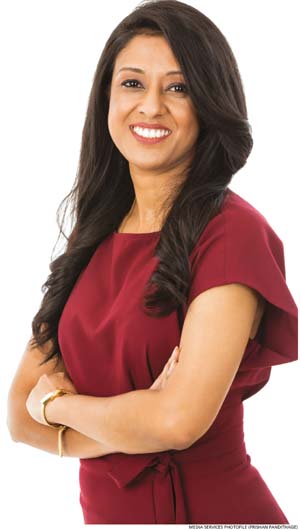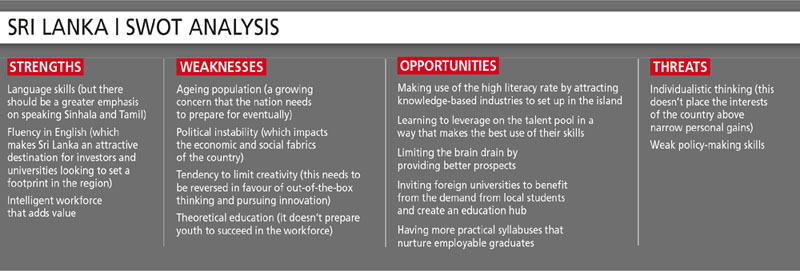EDUCATION SECTOR
ACADEMIC PATHWAY
Compiled by Yamini Sequeira
RESUSCITATING EDUCATION
Onalie Dissanayake calls for greater equity in Sri Lanka’s academic projects

The Constitution of Sri Lanka provides free education as a fundamental right – a boon in a developing nation that has resulted in the country gaining recognition for having one of the highest literacy rates in the world. In 1973, 30 percent of the national budget was allocated to education and it had risen marginally to 32 percent by 2016.
Onalie Dissanayake believes that “free education in Sri Lanka has been a major driver of growth for the country with this facility being provided right up to university level.”
She continues: “However, I believe that as a nation, we need to appreciate this by valuing education and desisting from participating in disruptive strikes, and frittering away education and public resources. After all, free education is made possible by taxpayers’ money.”
“Students should instead seize this opportunity to excel academically and give back to the nation through diligent service. Unfortunately, many believe it is their right and take free education for granted,” she laments.
EQUITY IN EDUCATION Dissanayake acknowledges the existence of inequalities in the quality of academic establishments particularly amongst national and provincial schools: “There is quality of education but perhaps its distribution is uneven – especially in remote locations. We should be able to ensure quality education across every school.”
“The system needs to change slightly so that you attend neighbouring schools, which will improve the overall quality of teaching rather than having the elite focussed on a few leading schools. This would reduce the burden on the system – especially as regards the lack of teachers and other resources,” she elaborates.
A rising middle class and higher disposable incomes gave rise to the proliferation of international schools. Although the move was opposed initially, time has demonstrated that these enterprises have not impacted national schools. In fact, it has simply offered a greater choice to students as to which type of institution they would like to study in, Dissanayake avers.

THE BIG PICTURE But unfortunately, this isn’t the case with universities. Take for example the South Asian Institute of Technology and Medicine (SAITM) about which Dissanayake opines: “Having a wider choice of public and private universities only provides more opportunities for students to gain qualifications, which in turn reduces competition without impacting state universities in any way.”
She adds: “In fact, establishing private universities would ease the burden on state universities, which are unable to offer seats to all students who complete their A-Levels.”
“But efforts to establish private universities have been blocked due to protests claiming they would create more competition for state university students. Unfortunately, a lack of choice forces students to look overseas, which causes brain drain and a loss of foreign exchange,” she points out.

Dissanayake reveals that foreign universities have expressed an interest in entering Sri Lanka – and therefore, a welcoming climate should be created without delay to attract top ranked global universities to set up branches in the island. Present global trends in education point to AI, big data, analytics, online and digital learning, and so on, which need to be offered to local students as well.
Elaborating on the highly competitive education sector, she observes “it has become a rat race with parents demanding that their children achieve high grades – and as a result, the focus is more on rote learning and grades rather than how much knowledge is gained. Even primary school students are being sent for tuition classes, which is nothing short of a tragedy.”
She advocates for the system to make a paradigm shift from offering teacher centric to child centric classrooms – i.e. by incorporating more practical learning. It is also the responsibility of parents to engage with and support their children at home, which should eliminate the need for tuition classes.

QUALITY VS. QUANTITY As for Dissanayake’s wish list, the priorities are for students to be exposed to lessons that emphasise soft skills such as social etiquette, empathy, tolerance and so on, to shape those who can become global citizens and grow up to be tolerant of differences – and whose worldview is broadened.
As for the supply side, Dissanayake comments: “We need teachers who are passionate about teaching and don’t view it as ‘just another other job.’ Passionate teachers can transform the futures of students who are lucky to be taught by them.”
“Admittedly, teaching is a low paying profession globally – and in Sri Lanka, teachers are perhaps not paid adequately. If their salaries were more competitive, we may be able to attract a better quality of teacher,” she says.
As for teacher training, only some state universities offer a Bachelor of Education degree.
CAREER GUIDANCE Meanwhile, the Technical and Vocational Education and Training (TVET) sector is still to attract large numbers and be considered as aspirational. This is where career counsellors should come in and guide students on what streams they can opt for in line with their talents.
“Very often, a child who opts for a vocational course may excel while they would be demoralised in academic subjects. Vocational courses should enjoy the same dignity and social status as their academic counterparts,” Dissanayake asserts.
She calls for more vocational and tertiary training centres for students so that they can explore different pathways, arguing that “many youth today want to become entrepreneurs and learn certain skills. The key is to offer them a choice to follow their passion rather than forcing them to follow traditional professions such as medicine, engineering and so on.”
EQUAL OPPORTUNITIES Dissanayake also notes that there’s a gap in education for underprivileged children and they need to be provided equal opportunities. The same applies to special needs children who need support from regular schools in order to be accepted.
“Gender disparities exist when it comes to education wherein the girl child may not receive as much education as boys. Only six percent of girls in schools in the country complete their A-Levels,” she reveals.
In conclusion, Dissanayake says: “If we’re able to correct this gender inequality in education, we will automatically see more female representation at the managerial and board level in business.”

The interviewee is the Country Head – Sri Lanka and the Maldives of the Chartered Institute of Marketing (CIM)



